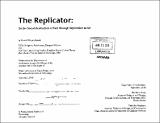The Replicator : on the social destruction of fact through replication as art
Author(s)
Ahmed, Haseeb Waqar
DownloadFull printable version (26.26Mb)
Alternative title
On the social destruction of fact through replication as art
Other Contributors
Massachusetts Institute of Technology. Dept. of Architecture.
Advisor
Ute Meta Bauer.
Terms of use
Metadata
Show full item recordAbstract
In the context of art to replicate is to re-create and transpose an architectural space that is geographically or historically remote in a chosen site in the present. The replica binds itself to the original and creates a register for continuity and change across vast expanses. The existent world is uzsed to produce its mirror image; those who see themselves in the original must confront their own image. In the practice of Replication an artist invests nearly all of her artistic freedom in a single decision: what should be reproduced in the present so that it may continue into the future? Together the Replicators proclaim 'The World has already been Made!' but what then delays utopia? In the last two years we have seen a massive upsurge in the use of replication as a strategy to produce meaning. Of these works I have chosen three: Yael Bartana's Wall and Tower (2009), Laurent Grasso's HAARP (2009), and Daniel G. Baird's Soyuz/ Progress (2008), that demonstrate a multiplicity of historical and technological concerns that are the inevitably object of replication. Replication belongs first and foremost to the scientific method as fact is only fact insofar as it can be reproduced anywhere in the world at any time.My contribution treats the technical institute of MIT as a site for the production of meaning instead of as a site for the production of reproducible technical knowledge. My works Shamshir+Windtunnel=Progress (2008-09), Daedalus: Holding Problem/Problem (2010), and the two part project The Sun Sets at Teufelsberg (2009) and Remote Viewing.: Teufelsberg (2010) seek to sustain and inhabit the space of translation between the original object and its replica. This thesis consists of in-depth studies of works by my contemporaries together with my own installations. Lastly I chart a path through art history beginning in 1968 that leads up to the development of the strategy of Replication in contemporary art in the present.
Description
Thesis (S.M.)--Massachusetts Institute of Technology, Dept. of Architecture, 2010. "September 2010." Page 127 blank. Cataloged from PDF version of thesis. Includes bibliographical references (p. 125-126).
Date issued
2010Department
Massachusetts Institute of Technology. Department of ArchitecturePublisher
Massachusetts Institute of Technology
Keywords
Architecture.